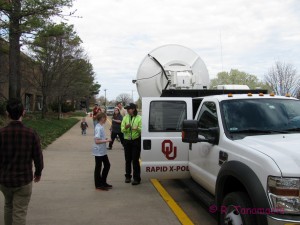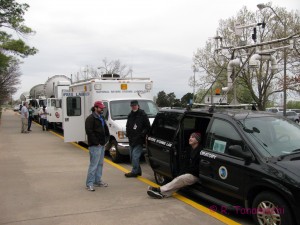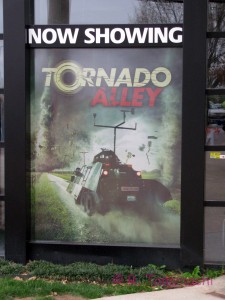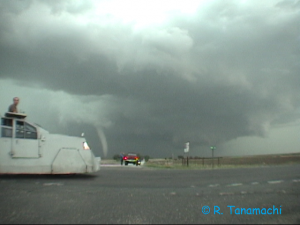


Tornado Alley is billed as Sean Casey’s magnum opus, the culmination of eight years of film-gathering in his Tornado Intercept Vehicle (“the TIV”). The film was partially sponsored by the National Science Foundation, who also sponsored VORTEX2. In the film, VORTEX2 mainly serves to provide a parallel story to that of the TIV crew, and that story is heavily CSWR-centric.*
Starting with the whale’s mouth swallowing the audience at the opening, Tornado Alley delivers the spectacular visuals that I’ve come to expect from IMAX. The filmmakers pack plenty of “torn porn” into 45 minutes. We see every frame of tornado footage they’ve got, and happily, they let the audience soak it in for 10-15 rapturous seconds before cutting back to the story. There’s a shot of a multi-vortex tornado that, in and of itself, is worth the price of admission. The IMAX format comes closest to capturing the all-encompassing experience of seeing a real tornado, minus the hours of driving, the bad food, and lightning danger.

With regards to the science, the film punches far below its weight, especially so considering that it’s an NSF-funded excursion. We get a few minutes’ explanation of how a supercell, and then a tornado, form. They don’t quite dumb it down to the clichéd, “cold air mass + warm air mass = tornado.” But it’s not much better than that, not to mention that the animations accompanying the explanations look relatively crude for 2011. There’s almost no attempt to tie this rudimentary understanding to the story. At one point, Bill Paxton announces, “Sean Casey has picked the wrong storm.” In my mind, I immediately cried out, “Okay, why is it the wrong storm?” But hungry minds like mine are left wanting. The narrative is so jumbled that I can’t figure out what day it actually was. I can’t even go back into my own chase logs and look it up.
The climax of the film is supposed to be Sean Casey capturing IMAX film from inside a tornado. “The Shot” turns out to be a bit of a let-down, but I can’t say I was surprised. Every serendipitous film or video I’ve seen from inside a tornado has shown blinding rain, flying leaves and branches, and not much else. There’s no glorious, Twister-esque view up the tornado’s throat, no choral accompaniment, no dancing lightning bolts, no maelstrom of recognizable debris. I left as convinced as ever that there’s no point, visually, to driving into a tornado, because there’s nothing to see there. (In fact, I’m starting to think that Mr. Will Keller may have been full of it.)
To sum up, Tornado Alley contains a few truly delectable tornado morsels. But at the end of the film, I felt like I’d eaten a single buffet plate, not a three-course meal.
*Just in case you’re wondering: I’m not in it. The IMAX crew took one shot of my team in hurry-up-and-wait mode at a park in Kimball, NE, in 2010, but that shot didn’t make the final cut. The big group drive-by shot also cuts in just after Team Howie is out of frame. Drat!